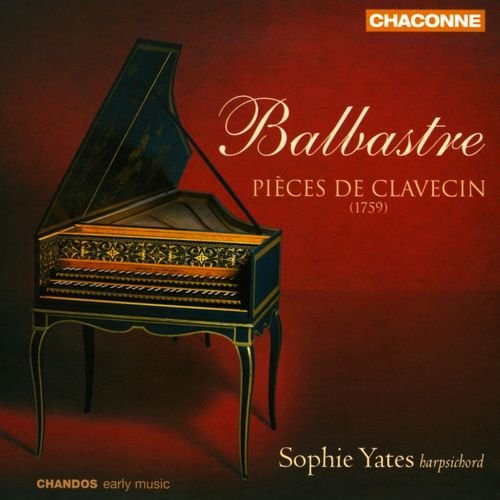Sophie Yates - Balbastre - Pieces De Clavecin (2011)

Artist: Sophie Yates
Title: Balbastre - Pieces De Clavecin
Year Of Release: 2011
Label: Chandos
Genre: Classical
Quality: FLAC (tracks+.cue,log,scans)
Total Time: 76:19
Total Size: 515 Mb
WebSite: Album Preview
Tracklist: Title: Balbastre - Pieces De Clavecin
Year Of Release: 2011
Label: Chandos
Genre: Classical
Quality: FLAC (tracks+.cue,log,scans)
Total Time: 76:19
Total Size: 515 Mb
WebSite: Album Preview
01. La de Caze. Ouverture. Fierement et marque, anime
02. La d'Hericourt. Noblement, sans lenteur
03. La Segur. Gavotte. Gracieusement
04. La Monmartel ou La Brunoy. Allegro
05. La Boullonge. Fierement et marqu‚
06. La Castelmore. Air Champetre. Loure - Gracieux
07. La Courteille. Air
08. La Bellaud. Vivement
09. La Lamarck. Ouverture. Vivement, marque
10. La Berville. Gavotte. Gracieusement
11. La Lugeac. Giga. Allegro
12. La Suzanne. Noblement et anime - Gracieusement
13. La Genty. Badine. Gaiement
14. La Malesherbe. Ariette. Gracieuse - Air. Gay
15. La Berryer ou La Lamoignon. Rondeau. Gracieusement
16. La Laporte [Allegro, anime]
17. La Morisseau. Noblement
Performers:
Sophie Yates, harpsichord
Composer Claude-Bénigne Balbastre came at the end of the French Baroque keyboard tradition that produced François Couperin and Jean-Philippe Rameau. Composed in 1759, these pieces look back toward the tradition of French harpsichord music, with its individual piece titles designating various members of the French nobility and their individual personalities. Thirty years after Couperin announced the reunification of French and Italian tastes, they show only light influence of Italian style; the clearly diatonic, periodic Allegro tune of "La Laporte," track 16, is the exception. Nor does Balbastre attempt to take after the intellectual density and harmonic complexity of Rameau's keyboard music. Instead his little musical portraits have a mostly pleasant, pastoral mien, with harmonic touches that are unusual and evocative rather than difficult. Sample the recurring, almost tickling emphasis on the flat fifth degree in "La Genty," track 13, or the large, static harmonic fields of "La Lamarck," track 9. This piece is marked "Ouverture," and part of what makes these works interesting is how they serve double duty as character pieces and as potential parts of an abstract structure. The playing of British harpsichordist Sophie Yates is nothing short of exemplary here. She doesn't try to make more of this light music than is actually in it, but she takes time where necessary to let the music breathe and to bring out small details, and there isn't a moment on the album that doesn't feel alive. She has the indefinable instinct for a command performance. Yates' own notes appear in English, German, and French.

![Mark Northam - More Music From The Pixar Films For Solo Piano (2025) [Hi-Res] Mark Northam - More Music From The Pixar Films For Solo Piano (2025) [Hi-Res]](https://img.israbox.com/img/2025-12/17/qc8ci6ocl25zt4m9ojnjn3k2k.jpg)



![Yasuhiro Usui, Ryoko Ono and Taro Tatsumaki - The House Concert Live Collection, Vol. 55: Yasuhiro Usui (Live at 3rd Floor, Artist House, Daehak-ro, Seoul, 7/12/2015) (2025) [Hi-Res] Yasuhiro Usui, Ryoko Ono and Taro Tatsumaki - The House Concert Live Collection, Vol. 55: Yasuhiro Usui (Live at 3rd Floor, Artist House, Daehak-ro, Seoul, 7/12/2015) (2025) [Hi-Res]](https://www.dibpic.com/uploads/posts/2025-12/1765791289_rchn1y2nh7yfb_600.jpg)
![Sibel Köse Septet - In Good Company (2025) [Hi-Res] Sibel Köse Septet - In Good Company (2025) [Hi-Res]](https://www.dibpic.com/uploads/posts/2025-12/1765846644_uizwujac4ht2d_600.jpg)

